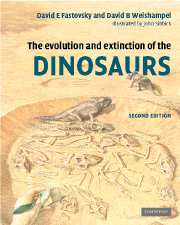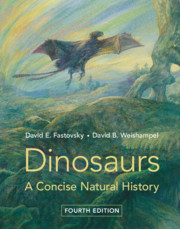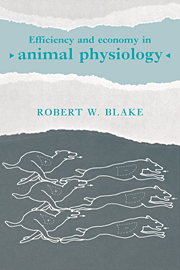The Evolution and Extinction of the Dinosaurs
This 2005 edition of The Evolution and Extinction of the Dinosaurs is a unique, comprehensive treatment of this fascinating group of organisms. It is a detailed survey of dinosaur origins, their diversity, and their eventual extinction. The book can easily be used as a teaching textbook for a class, but it is also written as a series of readable, entertaining essays covering important and timely topics appealing to non-specialists and all dinosaur enthusiasts: birds as 'living dinosaurs', the new feathered dinosaurs from China, 'warm-bloodedness'. Along the way, the reader learns about dinosaur functional morphology, physiology, and systematics using cladistic methodology - in short, how professional paleontologists and dinosaur experts go about their work, and why they find it so rewarding. The book is spectacularly illustrated by John Sibbick, a world-famous illustrator of dinosaurs, commissioned exclusively for this book.
- Covers all of the latest discoveries in dinosaur paleobiology written by two world experts
- Comprehensive and detailed, yet utterly readable and entertaining
- Beautifully illustrated by world-famous dinosaur artist, John Sibbick
Reviews & endorsements
From reviews of the previous edition: 'The book amply fulfils its objective of providing an authoritative, stimulating and lively introduction to dinosaurs. There are not many textbooks to which the epithets 'lively' and 'entertaining' apply, and that are friendly enough for a general reader … I can also warmly recommend it to interested general readers as the best available and thoroughly accessible account of dinosaurs and how they fit in with current scientific thinking - with the bonus that it presents the facts in an exciting manner, while dispelling the hype.' Angela Milner, New Scientist
From reviews of the previous edition: '… reflects the rigour of modern palaeontological research, and it will transmit the idea of method and testing to students, especially in terms of cladistic analysis of relationships, studies of macroevolution and of functional morphology. The book also conveys enthusiasm and excitement, two further principles of science that new generations of palaeontologists display in abundance … The presentation of the book is superb. The writing style is lively, and there are many amusing anecdotes and sidelines on popular attitudes to dinosaurs … There are even 14 colour plates, which is astounding in a textbook at this price.' Michael J. Benton, Trends in Ecology and Evolution
'… superb … It's engagingly written, authoritative, up-to-date, well illustrated, and bursting with enthusiasm. … The book is written as a university level text, but could easily be used to develop modular material for teaching at any level. I hope it will be. Highly recommended.' Biologist
'… it serves as an excellent primer on and about dinosaurs. … For the uninitiated this should prove to be a thoroughly good read …' Geological Magazine
'There is much in The Evolution and Extinction of the Dinosaurs to appeal to the non-specialist and dinosaur enthusiast as well as to the student market. The book covers exactly what it says on the jacket, including important sections on systematics using cladistic methodology that shows how dinosaurs relate to each other and to other animals. It offers more in-depth coverage of dinosaurs than broader vertebrate palaeontology textbooks … very good value.' The Times Higher Education Supplement
'… a fascinating and interesting book. Very well illustrated, it is of an easy understanding. Concise and clear …' Geobios
'One of the real strong features of The Evolution and Extinction of the Dinosaurs are its line drawings by John Sibbick, one of the foremost dinosaur illustrators who excels here as a textbook illustrator as well. … a great achievement by the authors and a substantial improvement over the first edition. It must have been a real challenge to write an update of this rapidly moving field, but the book very well manages to convey the excitement of the ongoing research on dinosaurs.' Journal of Zoological Systematics and Evolutionary Research
Product details
April 2005Hardback
9780521811729
500 pages
260 × 217 × 31 mm
1.376kg
250 b/w illus.
Available
Table of Contents
- Preface to the second edition
- Part I. Setting the Stage:
- 1. Introduction
- 2. Back to the past: the Mesozoic era
- 3. Discovering order in the natural world
- 4. Interrelationships of vertebrates
- 5. The origin of Dinosauria
- Part II. Ornithischia: Armored, Horned, and Duck-Billed Dinosaurs:
- 6. Stegosauria: hot plates
- 7. Ankylosauria: mas and gas
- 8. Pachycephalosauria: ramroads of the Cretaceous
- 9. Ceratopsia: horns and all the frills
- 10. Ornithopoda: the tuskers, antelopes, and 'mighty ducks' of the Mesozoic
- Part III. Saurischia: Predators and Giants:
- 11. Sauropodomorpha: the big, the bizarre, and the majestic
- 12. Theropoda I: nature red in tooth and claw
- 13. Theropoda II: the origin of birds
- 14. Theropoda III: the early evolution of birds
- Part IV. Endothermy, Environments, and Extinction:
- 15. Dinosaur thermoregulation: some like it hot
- 16. Patterns in dinosaur evolution
- 17. Reconstructing extinctions: the art of science
- 18. The Cretaceous–Tertiary extinction: the frill is gone
- Glossary
- Subject index
- Generic index
- Author index.






